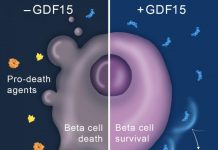A team of researchers from The Scripps Research Institute (TSRI) has discovered a way to use adult bone marrow stem cells to form new blood vessels in the eye or to deliver chemicals that will prevent the abnormal formation of new vessels.
This technique, which involves injecting the stem cells into the eye, could potentially be used to stimulate vessel growth and address inherited degenerations of the retina in the first instance, and in the second, to treat ocular diseases resulting from abnormal retinal angiogenesis, the aberrant growth of new blood vessels in the eye, which is the leading cause of vision loss in the United States.
"This is very exciting," says Martin Friedlander, M.D., Ph.D., who led the study. "We have shown that the cells can incorporate into the [degenerating] vasculature and make it normal."
"And when loaded with antiangiogenics, they can selectively wipe out the formation of new blood vessels."
Friedlander, who is Associate Professor in the Department of Cell Biology and Chief of the Retina Service in the Division of Ophthalmology, Department of Surgery at Scripps Clinic, has had a longstanding research program looking at ways of treating eye diseases that result from abnormal angiogenesis.
Continue Reading Below ↓↓↓
Abnormal angiogenesis is the cause of visual loss in age-related macular degeneration, where new blood vessels grow under the retina, and diabetic retinopathy, where abnormal vessels grow on top of the retina. The end result is much the same in these diseases--the normal structures for the transmission of light to the back of the eye are lost, and vision is catastrophically impeded in many of the tens of millions of Americans who suffer from them.
From stem cells to vessels
Adult bone marrow stem cells are "pluripotent" which means they have the potential to develop into a number of different cell types, such as red blood cells, platelets, or lymphocytes. The group's basic technique starts with selecting stem cells from the bone marrow that have the capability of becoming endothelial cells, the major cell type lining blood vessels.
Normally, retinal vascular formation occurs late in human prenatal development, when endothelial cells form a fine mesh of blood vessels in the back of the eye. In diseases like macular degeneration and diabetic retinopathy, aberrant vascular formation occurs later in life.
The vascularization in both diseases involves endothelial cells working in concert with another specialized cell--star-shaped cells called "astrocytes." These astrocytes, when activated, act as a template for vessel formation.
During prenatal human development, activated astrocytes guide endothelial cells into place where they can proliferate and form blood vessels. And later in life, activated astrocytes can also act as a template for endothelial cells to form blood vessels during angiogenesis.
Friedlander and his team found that they were able to target the activated astrocytes with the stem cell in vivo. They then tested these stem cells in a mouse model system of ocular disease. In normal mice, retinal blood vesssels form during the first three weeks after birth. In the disease model, the deeper retinal vessels completely degenerate by one month after birth.
In the ocular disease models, the stem cells differentiated into endothelial cells and proliferated, forming new blood vessels. This actually rescued and stabilized the retinal vessels when they would otherwise be degenerated.
They also found that they could shut down the angiogenesis by first transfecting the stem cells with a powerful inhibitor of angiogenesis--a fragment of the human protein tryptophanyl-tRNA synthetase (T2-TrpRS), which was discovered by TSRI Professor Paul Schimmel, Ph.D., and Friedlander and described in an article by the two investigators last year.
These transfected stem cells were also guided by the retinal astrocytes to the vasculature in the back of the eye where they expressed the T2-TrpRS protein and prevented the development of new retinal blood vessels without affecting already established blood vessels.
Continue Reading Below ↓↓↓
The research article "Bone marrow-derived stem cells target retinal astrocytes and can promote or inhibit retinal angiogenesis" is authored by Atushi Otani, Karen Kinder, Karla L. Ewalt, Francella J. Otero, Paul Schimmel, and Martin Friedlander and appears in the September, 2002 issue of Nature Medicine, appearing online as part of the advance online publication section of the journal's web site on July 29, 2002. See http://www.nature.com/nm/.
The research was primarily funded by the National Eye Institute with additional support from The National Cancer Institute, The Skaggs Institute for Chemical Biology, The Robert Mealey Program for the Study of Macular Degenerations, Merck KgaA, and the National Foundation for Cancer Research.
Source: TSRI









